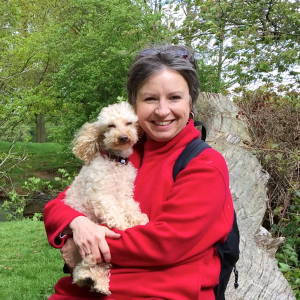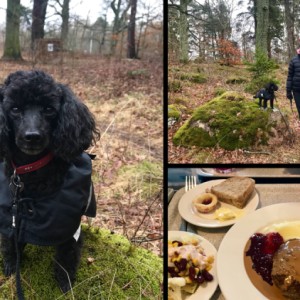Airplanes
It was a grey and wet day here in Linköping - but also warmer than when I arrived. All the snow is gone. Thankfully it did not rain during the time we took Alice on her 11 o’clock walkie. She had fun rock jumping as well as playing hide and seek with us.
After her walkies we had to leave Alice at home because Elisabet and I had lunch plans. There is a very nice restaurant at the nearby Swedish Air Force museum and I had requested to go there again during this visit. The restaurant is famous for the Swedish specialty dish - a Wallenberger - usually made with veal but the chef here makes it with wild boar. It was very very tasty (see Extra photo).
We spent a little bit of time looking at the planes inside as well as the two big ones outside the museum. I was quite intrigued with this one inside with the funny ‘feet’. It is an English J-8 Gloster Gladiator, Introduced in 1934. 55 of them were ordered by Sweden and 12 of them were used during The Winter War in Finland in 1939-40. Skis instead of wheels could be mounted onto the J-8, enabling operation on ice and snow; something that was essential during the Winter War.
The plane at top right is a DC-3 - introduced in 1935 and it quickly became the most popular commercial aircraft. The Swedish Air Force ordered a total of 8 of them from 1949. This particular one was actually delivered to the US Air Force in Europe in 1944. In 1946 it was sold to a Norwegian company and 2 years later to SAS. In 1960 it was purchased by the Swedish Air Force and flew for the last time in 1980.
The plane at the bottom right is the French Caravelle, the first passenger aircraft built with the engines mounted at the tail end of the fuselage instead of on the wings. Several versions were built between 1955-72. About 20 different airlines all over the world used the Caravelle (including United!). They were first operated by the Scandinavian Air Service (SAS), who had a total of 21 of them. This particular aircraft was bought by SAS in 1964 and was used as a passenger jet until it was sold to the Swedish Air Force in 1971. It was extensively rebuilt and was used for electronic intelligence flights. It was handed over to the museum after the final flight in 1998.
You can read Alice’s version of today here.


Comments
Sign in or get an account to comment.


